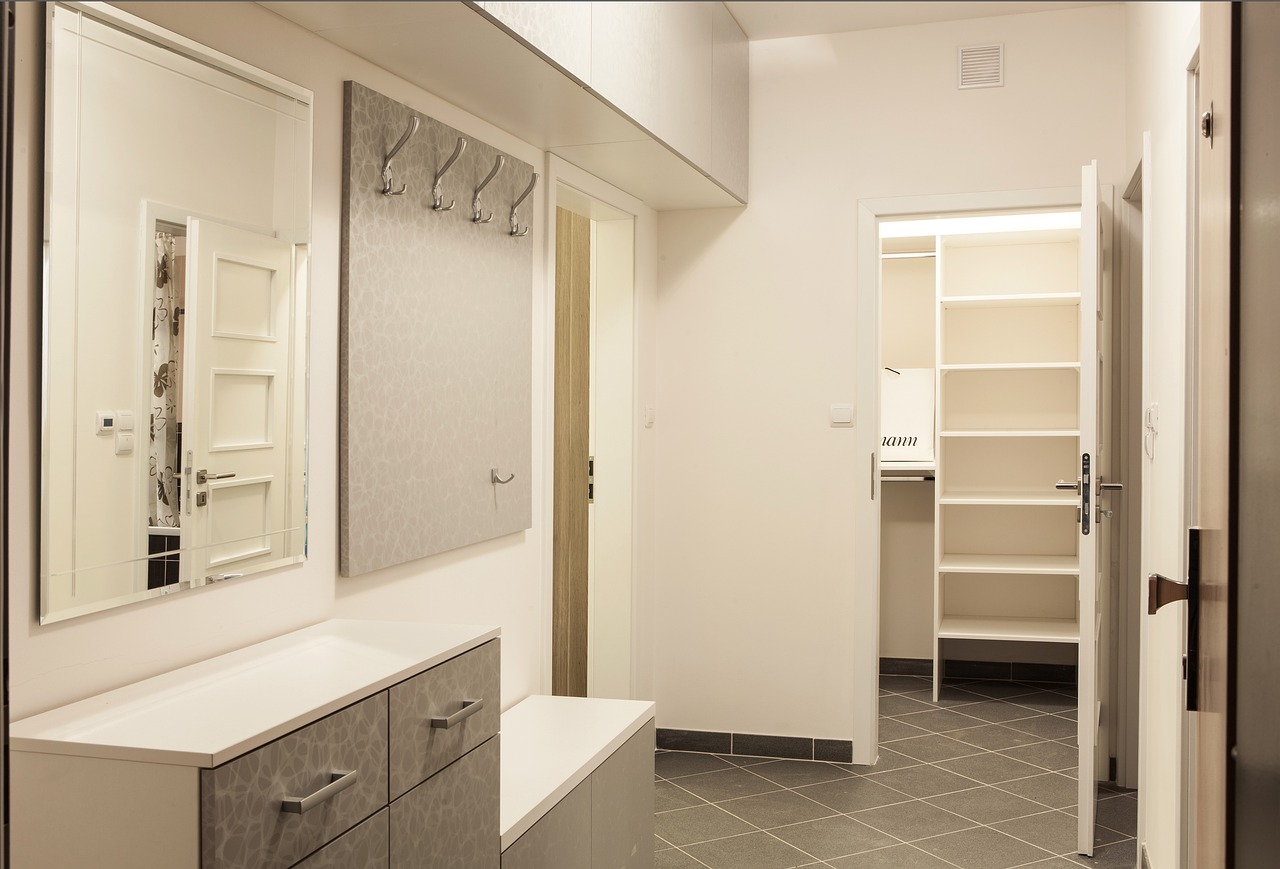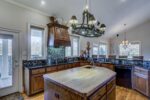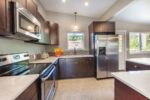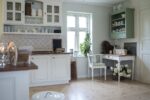When selecting new kitchen cabinets, it is probable that you wish to ensure that you acquire cabinetry of superior quality within your budget. The quality of cabinets is essentially determined by the material used to manufacture them.
Selecting the ideal material for kitchen cabinets (or any cabinets within your residence) establishes the functional ambiance and overall aesthetic for your area. The cabinet materials will ascertain the sturdiness, endurance, longevity, upkeep, adaptability, and overall design of the cabinetry.
To ensure the best purchase for your home when selecting cabinetry, familiarize yourself with the following top materials.
- Cabinet Materials
- Solid Wood
- Wood Veneers
- Plywood
- High-Density Fiberboard (HDF)
- Medium-Density Fiberboard (MDF)
- Thermofoil
- Laminate
- Melamine
- Particle Board
Anatomy of a Cabinet
The variety of kitchen cabinet materials available is extensive, with each material representing a unique level of quality, durability, aesthetics, and cost.
Having a basic understanding of cabinet construction can increase the likelihood of selecting the most suitable material for your specific cabinet component, as certain materials are better suited for certain areas.
Box meant for a cabinet.
The cabinet frame is mounted on the cabinet box which also serves as the storage area for items.
Overlays for Cabinet Doors
Styles of cabinet door overlays include:
- Inset – Where the door is installed flush with the frame for a flat, seamless face. The entire frame is exposed.
- Partial Overlay – Where the door sits on top of the frame and leaves 1-2 inches of the frame exposed.
- Full Overlay – Where the cabinet doors completely cover the cabinet box frame.
The structure of the cabinet
In a framed cabinet box, the cabinet frame serves as the anchor point for the doors and is attached to the front of the cabinet box.
- Framed cabinets have extra pieces of wood overlayed and “framing” the opening of the cabinet box.
- Frameless cabinets (also called European style cabinets) opt for no frame or extra wood on the cabinet box for a cleaner, sleeker design. Because of this, frameless cabinets require stronger, thicker base material to hold up to storage and use.
Panels used in cabinetry.
To conceal the unfinished sides of cabinet boxes, kitchen cabinet panels are attached to the exposed sides of cabinets, islands, and appliances. Panels come in different types, such as decorative end panels, dishwasher panels, and refrigerator end panels. By providing a uniform appearance across all cabinets, panels serve to complete the look of previously unfinished cabinets.
9 Best Kitchen Cabinet Materials
The overall structure of numerous cabinets could consist of a variety of materials that serve different functions within the cabinet. The following are the prevalent cabinet materials available in the market and their typical usage.
-
Solid Wood
According to CEO of Advanced Builders and Contractors, Nick Yahoodain, solid wood may be pricey, but its durability and natural appeal make it a worthwhile investment for kitchen cabinets. Its unique grain sets it apart from other materials in terms of appearance.
Solid wood has the advantage of being more durable and capable of easy sanding and repairs compared to other less sturdy choices. It should be noted that wood varieties such as hickory and maple, that are harder, are less susceptible to scratches and dents in comparison to walnut and mahogany which are softer.
Due to its high cost, solid wood is typically reserved for cabinet faces and doors, while less expensive materials are utilized for concealed components. In addition, proper finishing and long-term upkeep of solid wood can be a challenging task for those who choose to complete the task themselves.
Advantages: Long-lasting. Simplified repair process. Extensive range of colors and patterns available.
Drawbacks: Comes at a high cost and demands increased upkeep.
-
Wood Veneers
A wood veneer refers to a slender strip of genuine hardwood obtained by peeling or cutting it from a log. It is utilized in the production of wood-like panels by attaching it to plywood, medium-density fiberwood (MDF), or particle board. They are relatively slim, lightweight, and provide a cost-effective means of achieving a wood-like appearance for cabinets, as opposed to the pricier solid wood cabinet doors. Look at wood veneers as a means of delivering an attractive wood façade for your cabinetry.
and cons must be considered before making a decision. It is necessary to evaluate both the advantages and disadvantages prior to reaching a decision.
- Beautiful wood appearance
- Less expensive than solid wood
- More durable than laminate
- Resistant to warping
- Easy to maintain
istency is key in achieving success, therefore it is important to have a solid routine and stick to it.
- Susceptible to water damage
-
Plywood
Plywood is a widely used material in the manufacturing of cabinets. It is composed of thin wood slabs, also referred to as flitches, that are arranged in opposing directions and united with adhesive. Unlike particle board, plywood is highly resilient. To grant the impression of natural wood, a decorative wood veneer is frequently applied to the plywood for cabinet boxes.
Among the engineered wood choices available, it is the most robust, which makes it the optimal selection for cabinet boxes, drawer bottoms, shelves, and frames.
It should be noted that the price, durability, and appearance of plywood can be impacted by its grade, which ranges from AA, B, C, D, to E.
and cons of a situation need to be carefully considered before making a decision. It is important to thoroughly assess the advantages and disadvantages of a circumstance prior to reaching a conclusion.
- Less expensive than wood
- Strong & durable enough to hold heavy items
- Holds its shape against humidity and temperature changes
- Takes a veneer to get a wood-look cabinet
- Holds screws and nails well
- Water-resistant
idering the fact that it is an essential part of the job, I believe that learning how to use technology competently is an absolute necessity for all employees.
- More expensive than other engineered woods
- Not as strong as solid wood
- Low-quality plywood comes apart and splinters easily
-
High-density Fiberboard (HDF)
High-density fiberboard, also known as hardboard, is a type of engineered wood comprising wood fibers blended with resins and adhesives. It yields the toughness and visual appeal of wooden cabinets at a more affordable cost. Moreover, it is denser than natural wood but relatively cheaper than both plywood and hardwood.
Cabinet panels perform efficiently when made of HDF.
and cons should be thoroughly considered before making a decision. Careful consideration should be given to both the advantages and disadvantages prior to making a choice.
- Extremely hard
- Stable in humid and dry environments
- Takes paint well
ider this option carefully before making a decision. Think about the potential consequences and weigh the pros and cons. It’s important to make an informed choice.
- Susceptible to water damage
- Cannot hold screws or nails
- Lacks lifespan of hardwood
- No wood grain
-
Medium-density Fiberboard (MDF)
MDF, which stands for medium-density fiberboard, is produced by combining and compressing wood fibers with glue, resulting in a sturdy substance commonly used for cabinet doors and box constructions. Even though it is not as resilient as solid wood or plywood, MDF costs less.
MDF has a seamless texture and no visible wood grain, making it a feasible choice for custom painting. “MDF is an excellent choice for those seeking a grain-free material for cabinets,” advises Yahoodian. Before painting, it’s crucial for DIY enthusiasts to recognize that MDF is porous and should be correctly sealed to avoid water infiltration.
Due to the structure of MDF, repairing it is challenging and sanding it down is not feasible, resulting in permanent chips and scratches.
Advantages: Inexpensive. Simple to apply paint. Resistant to warping.
Disadvantages: Cannot be subjected to sanding and prone to getting damaged.
-
Thermofoil
Cabinets made of thermofoil utilize a material resembling foil that is heat-sealed over MDF. If you opt for high-gloss thermofoil, the resulting surface is reflective and lustrous, enhancing your kitchen’s apparent size and brightness.
There are benefits to using a robotic vacuum cleaner.
- Inexpensive
- Easy to clean
- Resistant to warping and fading
- Variety of shapes, colors, patterns, and designs
- Potential to be used on shaker or simple arch cabinet doors
ume less, waste less.
- One side doesn’t match the others (usually the back side)
- Susceptible to peeling away from the core
- Prone to scratches
- Difficult to reface or paint
- Sensitive to heat and moisture
- High gloss shows fingerprints and dirt
-
Laminate
Laminate, a synthetic plastic material with a smooth surface, is often used to cover plywood or MDF. Its common usage is for cabinet doors, making it a viable option for cabinet refacing. According to Yahoodain, laminate is available in two types: low-pressure and high-pressure. The latter, which includes brands like Formica and Wilsonart, is more hard-wearing, while the former, composed of melamine, is more economical.
Laminate’s easy-to-clean surface is not suitable for painting, which is important for DIYers to remember. When it comes to painting laminate cabinets, it is necessary to sand them and employ special paint that attaches to the surface correctly. Therefore, if you plan to alter the color, consider this.
Advantages: Simple to maintain. Affordable. Diverse selection of colors and artificial wood textures.
Drawbacks: Painting it is a challenging task. Repairing it poses great difficulty.
-
Melamine
Melamine is a laminate surface that has a plastic coating applied to plywood or fiberboard. It is composed of paper and resin, much like laminate, and is formed by combining them with heat. However, it is less expensive to manufacture.
Melamine comes in different grades which determine its quality. Melamine of inferior quality has a shorter lifespan when compared to laminate. Conversely, textured thermal-fused melamine is thicker and has the potential to outlast high-pressure laminate (HPL).
By incorporating textured melamine, the paper designs within the resin compound achieve a more realistic appearance and tangible feel, resembling actual wood rather than a fabricated version.
and cons should be taken into consideration before making a decision. It is important to weigh the advantages and disadvantages before reaching a conclusion.
- More affordable than laminate or solid wood
- Versatile in colors, patterns, and designs
- Durable
- Scratch resistant
- Sustainable and affordable
idering the current circumstances, we have decided to postpone the event until further notice.
- Can’t be refinished
- Uses potentially harmful adhesives
- Lower-quality wood material
-
Particle Board
Particle board, produced by compressing wood particles like sawdust and wood chips with heat and resin, is a type of low-density fiberboard commonly used to create cabinets with a polished appearance, frequently coated with a veneer or laminate.
Drawer boxes typically perform well when made of particle board.
and Cons Advantages and Disadvantages
- Inexpensive
- Versatile in appearance
- Uses wood byproducts and recycled materials
ervatives advocate for traditional values and policies that prioritize limited government intervention and individual freedom.
- Least durable wood product for cabinetry
- Sags under heavy dishes, countertops, or appliances
- Easily chipped or broken
- Susceptible to moisture damage
How to Select Durable, Quality Cabinets
Thanks to the various cabinet materials available, it is possible to find and purchase kitchen cabinets that are both affordable and long-lasting.
To maximize your budget when buying cabinets, consider purchasing RTA (ready-to-assemble) cabinets that are shipped in flat packages, which are less costly to transport compared to large, pre-built cabinets.
Opting for superior materials in your kitchen cabinets would offer sturdiness, longevity, and endurance, as well as enhance the resale value of your home. The lifespan of the materials increases proportional to their quality.
Cabinets that are cheap and low in quality or durability are more vulnerable to damage and have a shorter lifespan compared to their more durable counterparts. As a result, you might have to replace them sooner, leading to higher costs in the long term.
When considering the investment in kitchen cabinets, keep in mind that spending a bit more initially could ultimately prevent additional expenses and avoidable anxiety in the future. Understanding the different materials used in cabinets can greatly aid the selection of durable options, allowing you to confidently invest in high-quality kitchen cabinets that will be worth your money.
Our suggestion is to select cabinet materials that have endurance and strength, including engineered wood, wood veneers, PET laminate, or thermal-fused thermofoil combined with high-quality MDF or plywood, or solid wood (assuming you have the financial means).






